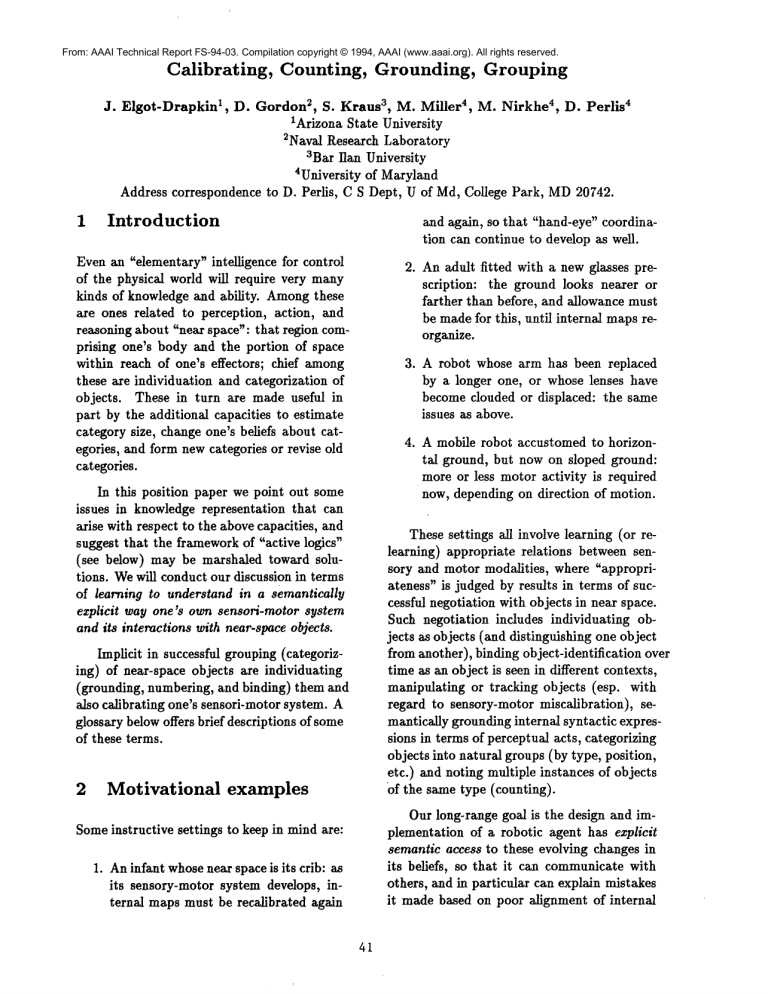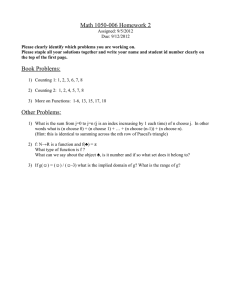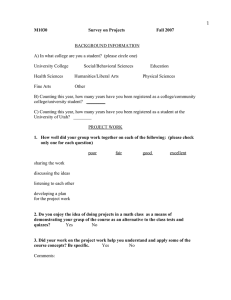
From: AAAI Technical Report FS-94-03. Compilation copyright © 1994, AAAI (www.aaai.org). All rights reserved.
Calibrating,
Counting,
Grounding,
Grouping
4
J. Elgot-Drapkin 1 , D. Gordon2, S. Kraus3, M. Miller 4, M. Nirkhe4, D. Perlis
1Arizona State University
2Naval Research Laboratory
3Bar Ilan University
4University of Maryland
Address correspondence to D. Perlis, C S Dept, U of Md, College Park, MD20?42.
1
Introduction
and again, so that "hand-eye" coordination can continue to develop as well.
Even an "elementary" intelligence for control
of the physical world will require very many
kinds of knowledge and ability. Amongthese
are ones related to perception, action, and
reasoning about "near space": that region comprising one’s body and the portion of space
within reach of one’s effectors; chief among
these are individuation and categorization of
objects. These in turn are made useful in
part by the additional capacities to estimate
category size, change one’s beliefs about categories, and form new categories or revise old
categories.
.
.
.
In this position paper we point out some
issues in knowledge representation that can
arise with respect to the above capacities, and
suggest that the frameworkof "active logics"
(see below) may be marshaled toward solutions. Wewill conduct our discussion in terms
of learning to understand in a semantically
explicit way one’s own sensori-motor system
and its interactions with near-space objects.
Motivational
A robot whose arm has been replaced
by a longer one, or whose lenses have
become clouded or displaced: the same
issues as above.
A mobile robot accustomed to horizontal ground, but now on sloped ground:
more or less motor activity is required
now, depending on direction of motion.
These settings all involve learning (or relearning) appropriate relations between sensory and motor modalities, where "appropriateness" is judged by results in terms of successful negotiation with objects in near space.
Such negotiation includes individuating objects as objects (and distinguishing one object
from another), binding object-identification over
time as an object is seen in different contexts,
manipulating or tracking objects (esp. with
regard to sensory-motor miscalibration), semantically grounding internal syntactic expressions in terms of perceptual acts, categorizing
objects into natural groups (by type, position,
etc.) and noting multiple instances of objects
of the same type (counting).
Implicit in successful grouping (categorizing) of near-space objects are individuating
(grounding, numbering, and binding) them and
also calibrating one’s sensori-motor system. A
glossary belowoffers brief descriptions of some
of these terms.
2
An adult fitted with a new glasses prescription: the ground looks nearer or
farther than before, and allowance must
be madefor this, until internal mapsreorganize.
examples
Our long-range goal is the design and implementation of a robotic agent has explicit
semantic access to these evolving changes in
its beliefs, so that it can communicatewith
others, and in particular can explain mistakes
it made based on poor alignment of internal
Someinstructive settings to keep in mind are:
1. Aninfant whosenear space is its crib: as
its sensory-motor system develops, internal maps must be recalibrated again
41
model. This will be important both to help
it avoid future mistakes (or recalibrate more
quickly) and to warn others to watch for similar problems.
Specific capabilities we wish to build into
an artificial agent in the next few years are:
1. calibrate its internal self-model as needed
to allow appropriate interaction with near
space, and recalibrate in the face of changes
in its perceptual or motor systems
2. perceptually pick out objects in its near
space
3. properly individuate, count, and keep
track of those objects in an internal language
4. classify those objects into appropriate
categories
5. reason about those categories, e.g., count
or estimate sizes, form and apply defaults, etc.
6. revise categories and category membership as needed
3
Wehave selected reasoning about near space
because we think categorizing is both easier
and more important there than in far space.
Certainly infants and simple organisms deal
primarily with near space; and imminent threats
to survival tend to be in near space even for
complex agents. It is plausible that most of
our mental machinery has evolved in ways that
are facilitative of near-space reasoning.
Calibration and grounding are inherently
agent-oriented, whereas counting and grouping are less obviously so. Calibration and grounding refer to the agent’s ability to coordinate
perception and motion and (in our view) explicit beliefs about the agent’s body in relation to near space. Somerelated work by others on calibration, grounding, and self-models
includes [1, 9, 15, 5, 7]. Confusionand contradiction can easily arise in near-space (due to
noisy or conflicting data from multiple modalities, or from defaults gone wrong), and the
recognizing of such is a crucial step in setting one’s world view right again; this is where
symbolically explicit calibration can enter importantly.
Counting and grouping are more general
tasks, but again in our view they can (and
should) be seen as extensions of basic measurements the agent can carry out based on
fundamental notions of its own bodily measurements, in an internal self-model. (This
also bears on the so-called active-vision paradigm,
which maintains that the intentions and actions of the seeing agent are critical to its visual computations.)
Discussion
Someof our previous work [3, 2, 6, 10, 8, 14,
11] treated rather disjointed aspects of this
long-range problem. In this position paper
we simply single out four key aspects of the
more integrative long-range task: calibration,
counting, grounding, and grouping.
It is of interest that although categorization (grouping) has received a great deal
attention by psychologists [4], little study has
been made on the human use of categories
to advance default inferences. Thus much is
known about how humans come to classify
something as a bird (e.g., by comparison with
a prototype feathered creature), but not much
about how humans then draw further inferences about that object (e.g., that it can fly).
On the other hand, in AI much attention has
been given to the latter, but less to the former. Wewish to bring these two areas closer
together, using active logics as a formal tool in
Some aspects of the larger task are not
ones we intend to address, especially those
bearing most directly on basic perceptual or
motor skills (vision and robotics). Wealso
are not explicitly concerned with qualitative
physics in the usual sense [16], but rather principaUywith an agent’s self-models as they incorporate information about dealing with near
space. Self-models and near space are what
we are now beginning to focus on in some of
our current research.
42
which change of belief over time can be modeled. Webelieve their combination to be fundamental to intelligent near-space behavior.
In each of our four key capabilities, learning must take place in order for appropriate
behavior to be possible: the agent must learn
a newrelation betweenits body (sensors or effectors or both) and its near space, along with
individuation of objects and their categories
and quantities. Whilesuch learning is possible
without explicit symbolic representation (indeed probably is most commonlyso), there is
added benefit to having some explicit knowledge and even meta-knowledge of the process
of learning. Wegave somebenefits above. Another is that an agent whois aware of the discrepancy between its current sensory-motor
behavior and its desired behavior (e.g., in reaching for objects but missing them) may take
more care during the learning period, so as
to makefewer (or less drastic) mistakes until
automatization occurs.
The portion of the meta-reasoning that we
have been working on to date includes representational tools for change in belief and
for recovery from contradictory beliefs. Others to be worked on include change in category; magnitudes (cardinal and ordinal counting and measurement); sets [13, 12] (as convenient representations for both categories and
counting); and rule-learning (automatization
of explicit beliefs about actions).
Category discrimination in itself may be
largely perceptual and is not the direct focus
of our concern here. Rather, our topic is the
reasoning about categories that one can discriminate. There are several issues in knowledge representation that arise here, that appear not to have been addressed in existing
work. Chief amongthese is counting: simple
arithmetical skills such as comparingrelative
sizes of two categories, or noting that a category has exactly three members, all of which
share a salient property, are taken for granted
in human behavior, and are extremely useful. Yet they are generally left out of computational models. Closely related to "numerosity" is change of belief, for the process
of size-estimation leads to new information
about categories, that mayrequire revising of
previous beliefs. Size-estimation in turn we
will relate to bodily measurements, alluded
to above; preliminary work on this is found
in [14, 11].
4
Active Logics
Our perspective is that active logics mayprovide a useful (even crucial) tool for addressing the issues of calibrating, counting, grounding, and grouping of near-space objects and
actions in a semantically explicit way. The
principal reason for our view is that all four
of these capacities are ones where error and
belief-revision will be commonoccurrences. Active logics were developed largely to deal with
just such matters, with special meta-inference
rules to recognize and contain errors. This is
one form of self-modeling, and is related in
a general way to the above comments about
measurement as well.
In 1986 we coined the term "step logics"
for a new kind of time-situated reasoning, in
which the passage of time during reasoning is
itself encoded in the syntax of the logic, via
special time-sensitive inference rules. These
were used to provide time-situated solutions
to a number of problems in commonsensereasoning, including default reasoning, reasoning
about others’ beliefs, planning with deadlines,
and recognizing and correcting errors (including contradictory beliefs). Morerecently, we
have adopted the term "active logics" as both
more descriptive and also more general, to allow learning of new syntactic expressions (lexicon growth) and altering of semantic content
of existing expressions (semantic shift), in addition to the features of step logics.
An active logic is both an abstract rule
system and an inference engine that produces
theorems (beliefs) using those rules. Their
single most unusual feature is a special rule for
the predicate Now(t) whose intended meaning is "the time is nowt". As the logic produces theorems over time, a sequence of wifs
of the form Now(t) become briefly believed
and then replaced by the next in the sequence:
References
Now(O), Now(l), Now(2),...so that the
gument t to the currently-believed Now(t) is
a dynamic measure of the actual (changing)
time as the logic draws inferences. In effect
an active logic has a wristwatch that it checks
to update its belief as to what time it is, in
parallel with its other reasoning.
[1] G. Drescher.
Press, 1991.
MIT
[2]J.
Elgot-Drapkin,
M. Miller, and D. Perlis. Memory,reason, and time: the step-logic approach.
In R.. Cumminsand J. Pollock, editors,
Philosophy and AI: Essays at the Interface. MITPress, 1991.
This "wristwatch" is the key to most of the
special capacities of active logics, and wehave
used it extensively in addressing the problems
listed two paragraphs above. In particular,
it facilitates a powerful and computationally
tractable kind of meta-inference. It is our
hope that we will have equal success in finding semantically explicit solutions to the problems of calibrating, counting, grounding, and
grouping, for all of these are ones whereerror
and revision of beliefs will be frequent.
5
Made-Up Minds.
J. Elgot-Drapkin and D. Perlis. Reasoning situated in time I: Basic concepts.
Journal of Experimental and Theoretical
Artificial Intelligence, 2(1):75-98, 1990.
H. Ellis and R. Hunt. Fundamentals of
Cognitive Psychology. William C. Brown
Communications,fifth edition, 1993.
[5] G. Fanconnier.
Press, 1985.
Glossary
Mental Spaces.
MIT
D. Gordon and D. Perlis. Explicitly biased generalization.
Computational Intelligence, 5:67-81, 1989.
Calibration: setting up appropriate internal
maps to put sensory modalities in correspondence with one another and with motor systems, to allow coordinated sensori-motor behavior. Such maps need to be adjusted, during growth and other times of physical change.
[7]M. Johnson.
The Body in the Mind. University of Chicago Press, Chicago, IL,
1987.
[8]M. Miller
and D. Perlis. Presentations
and this and that: logic in action. In Proceedings of the 15th Annual Conference
of the Cognitive Science Society, Boulder,
Colorado, 1993.
Individuation: picking out aspects of perceptual space as being (or representing) real
individual objects; thus two red balls are individuated as two objects, not one. Related
to counting.
[9]V.
Nenov. Perceptually grounded language acquisition: A neural/procedural
hybrid model. PhD thesis, University of
California at Los Angeles.
Grounding: tying internal symbols to the
external entities they represent; that is, providing the means by which internal symbols
can represent specific external entities. Related to counting: one object-symbol should
not be grounded in two different objects.
[10]M. Nirkhe,
S. Kraus, and D. Perlis. Fully
deadline-coupled planning: One step at a
time. In Proceedingsof the Sixth International Symposium on Methodologies for
Intelligent Systems, Charlotte, NC, 1991.
Binding: Manypercepts can "represent" the
same external object (e.g., visual, auditory,
tactile); these must somehowbe tied together
cross-modally as well as over time, to form a
representation of a single external object.
[11] D. Perlis. Putting one’s foot in one’s
head--part H: How. In E. Dietrich, editor, From Thinking Machines to Virtual
Persons: Essays on the Intentionality of
Computers. Academic Press. To appear.
44
[12]D.
Perils. Circumscribing with sets. Artificial Intelligence, 31:201-211,1987.
[13]D. Perlis. Commonsenseset theory. In
P. Maes and D. Nard], editors, MetaLevel Architectures and Reflection. North
Holland, 1988.
[14]D. Perlis. Putting one’s foot in one’s
head--part I: Why. No~s, 25:435-455,
1991. Special issue on Artificial Intelligence and Cognitive Science.
[15] T. Regier. The acquisition of lezical
semantics for spatial terms: A connectionist modelof perceptual categorization.
PhDthesis, University of California at
Berkeley, 1992.
[16]D. Weld and J. de Kleer, editors.
Readings in Qualitative Reasoning About
Physical Systems. Morgan Kaufmann,
1990.
45





